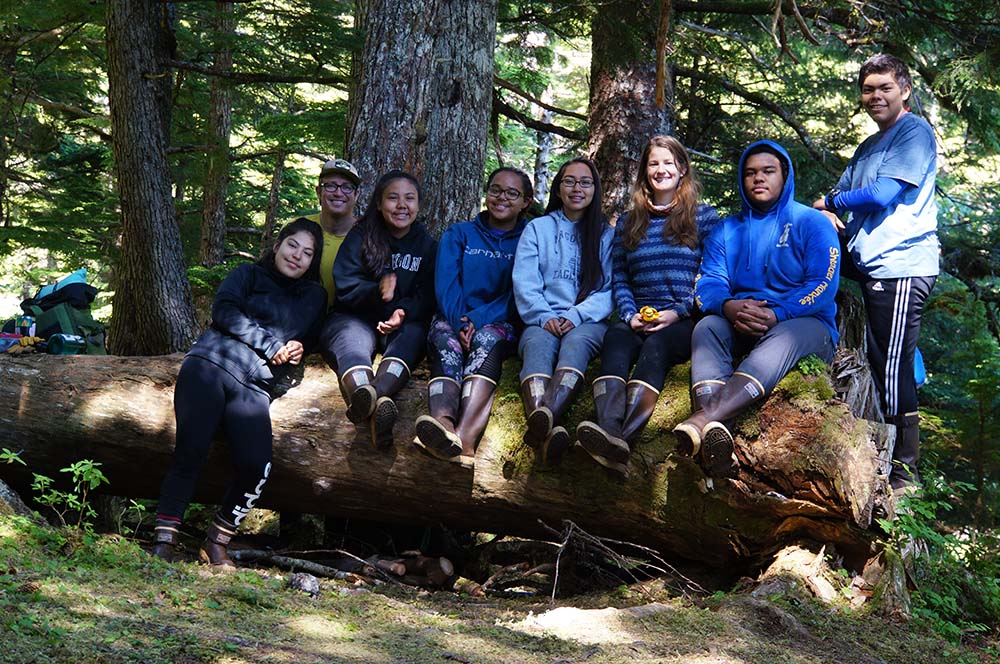How Alaska LIFT Miles support forest restoration across the country
Share

A trail crew member places new planks for a trail walkway on the Mt. Baker-Snoqualmie National Forest. (Photo by Aukshunas Photo, courtesy the National Forest Foundation.)
Last year, more than 15,000 volunteers with the National Forest Foundation worked to restore 67,000 acres of wildlife habitat across the country, repair 125 miles of public trails and engage more than 7,500 young adults in forest restoration activities, introducing the next generation of stewards to their public lands.
And in strategic wildfire-prone areas of California, NFF teams are preventing future disasters by thinning 7,900 acres of forestland within the Tahoe National Forest and more than 4,000 acres in the American River Ranger District near Sacramento.

Alaska Airlines Mileage Plan members support these and other NFF projects to restore and protect the nation’s 193 million acres of national forests and grasslands by donating miles through Alaska’s LIFT Miles program. These miles allow NFF staff to travel to sites across the National Forest System – from Alaska to California to Washington, D.C. – to meet with partners, host events and volunteer opportunities, and oversee projects. Since 2013, Alaska guests have donated more than 5 million miles in support of the National Forest Foundation work. In 2019, NFF staff traveled more than 1 million miles on Alaska using these donations. Learn more about how to donate miles to the NFF and other causes supported by LIFT Miles.
“Alaska Airlines miles donated to the National Forest Foundation are critical for our work,” says NFF President and CEO Mary Mitsos. “These miles enable us to travel across our voluminous National Forest System to conduct our mission to engage Americans and improve forest health.”

Here are a few highlights from the National Forest Foundation’s work in 2019:
Engaging young adults with their forests in Southern California
For many urban residents, especially minority youth, access to and knowledge of public lands is limited. At the same time, forests in the backyard of urban areas are suffering the impacts of inexperienced users. In Southern California, the NFF is addressing this challenge through the Junior Field Ranger Program. More than 150 teens have participated in the program over the past six years. Program participants receive STEM-based outdoor education and training as certified California naturalists. This training earns them college credit and provides them with sufficient experience to interact with the public around basic conservation education.
“Before I joined the Junior Ranger Program, I didn’t realize the Angeles National Forest was this close,” says Carlos Regalado, age 16 and a resident of Los Angeles.
A key component of the program includes interacting with forest visitors. Thanks to the Junior Rangers, visitors learn how littering, creating unofficial trails and damming streams can adversely impact local water resources and wildlife habitat.
Helping rural Alaskan youth connect with public lands

(Photo courtesy U.S. Forest Service)
For the fifth year, the National Forest Foundation has partnered with other organizations to support the Angoon Youth Conservation Corps (YCC) in Southeast Alaska’s Admiralty Island, where brown bears outnumber residents 3 to 1. For the six Native Alaskan crew members working on the Angoon YCC, this is often their first job.
Throughout the summer, the crew’s primary objectives are conservation-based – maintaining trails, cabins and campsites, and restoring habitat by cleaning up debris along shorelines and removing invasive species. They kayak to and camp at many of the remote sites they are working. The youth also engage other village residents in volunteer events, and have begun a campaign to teach them about the dangers of marine debris to wildlife. In addition to these benefits for the surrounding Tongass National Forest, the participants also acquire professional skills.
Restoring a popular trail in the temperate rainforests of Washington
The NFF, with partner EarthCorps, just completed 500 hours of work to improve the popular Lake 22 Trail on the Mountain Loop Highway near Seattle. The crew upgraded the trail tread to improve drainage and built a new bridge from natural materials. This work will make the hike more pleasant for users, and will keep sediment out of the streams. This work will ensure visitors can continue to access this hike to Lake 22, which combines the best of old-growth rainforests, wetlands, and mountain views on the stunning Mt. Baker-Snoqualmie National Forest.
The NFF will continue projects in this area for the next five years including a new Treasured Landscapes site just east of Everett, Washington. Alaska Airlines miles donated through LIFT Miles will support NFF work to enhance outdoor recreation sites to accommodate increased visitor use; to restore watershed health and aquatic ecosystems to benefit threatened salmon and steelhead as well as other wildlife species; and to increase the number and diversity of people stewarding the National Forest for future generations. Alaska Airlines’ new flights into Paine Field allow NFF staff to travel efficiently to and from the project sites to support implementation.
As we reflect on the work we’ve accomplished together in 2019, we are already planning for what’s ahead in 2020. With your partnership, we’ll continue to support our public lands for future generations. Learn more and donate Alaska miles to the National Forest Foundation.

